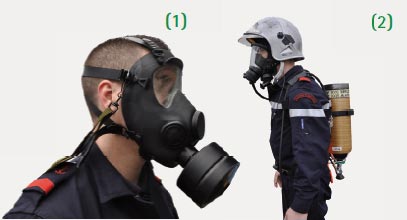
Vessel crews and response teams must have access to
Personal Protective Equipment (PPE) stockpiles. The
content and size of these stockpiles is closely linked
to the type and quantity of substances handled or
liable to be handled.
Marine response PPE comprises protective clothing,
either single-use or reusable, often combined with
respiratory protection. In addition, different accessories
may prove essential to ensure optimal operator
protection: gloves, boots, goggles, helmet and ear
protectors. The materials of which they are made will
vary according to the substances to which they must
be resistant and the circumstances surrounding the
incident.

European standards define six types of clothing
(ranked from 1 to 6) according to their level of
protection. Canada and the United States, on the
other hand, have their own classification which
combines both protective clothing and breathing
apparatus (ranked from A to D). There is no direct
correlation between the two standards but some
equivalences can be drawn. For instance, an American
level B is comparable with a European type 3.
Air-purifying respirators (APR) are composed of an
air-tight mask and a cartridge that contains a filter
suitable for one or more gases. They are compact and
light, but are specific to a given substance.
Self-contained breathing apparatus (SCBA) are
bulkier than APR. They are used to work in an
asphyxiating atmosphere as those wearing them
breathe the compressed air container in the bottle.
Self-contained breathing apparatus (SCBA) provides a service time of 20 to 45 minutes according to the type of response operations and the equipment used.
Poster summarizing the different personal protective equipment used in Europe in the event of marine spills of hazardous and noxious substances: www.arcopol.eu/_docs/resources/ACT4/FichasENG/Ficha_2_EPIs_EN_web.jpg

The International Maritime Organization
(IMO) has developed a wide range of
tools, including standard training courses,
manuals and guidance documents to help
countries to develop their capacity to deal
with incidents involving hazardous and
noxious substances (HNS). Member States
can also request assistance from IMO,
through its Integrated Technical Co-operation
Programme, in order to satisfy their
obligations and implement the provisions
of the Protocol on Preparedness, Response
and Co-operation to Pollution Incidents by
Hazardous and Noxious Substances, 2000
(OPRC-HNS Protocol).
Last update: 07/12/2016